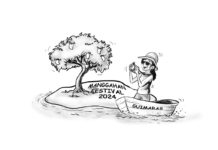
BY JAZMIN BANAL
BOHOL is beautiful. You can visit it several times and still appreciate its charm.
Last year, I realized it can be considered as more accessible than other local spots because of cheaper flights from Manila. It is also reachable by ferry and bus.
In that recent trip, Bohol has shown its rustic vibe, entrepreneurial spirit, and style. There were ihaw-ihaw places with just enough space for a few locals and tourists and without hindering the flow on the road. There were motorcycles for rent, the transactions uncomplicated and which seemed, somehow, to be operated also on trust. Cafes and shops with interesting details kept up with design trends while remaining intimate.
Even the institution that is the Bohol Bee Farm had its surprises, with their own ice cream, woven cloth, delicacies, and ocean-view dining with bread, salad, and baked scallops.
The St. Augustine Church offered carvings and murals and some quiet time.
Earlier visits centered on nature — Chocolate Hills, Loboc River, Bilar Man-Made Forest, Tarsier Sanctuary, Alona Beach and Danao Beach in the southwest of Panglao Island, Dumaluan Beach and Libaong Beach in the southern portion, Doljo Beach in the northwestern tip. There wasn’t enough time to experience all the scenery and diversity. The island is that rich.
Pre-pandemic, visitor arrivals reached one and a half million. Even after the 2013 earthquake, arrivals had increased. (Source: DOT Region 7)
In 2018, Bohol opened its international airport. With direct international flights, foreign arrivals helped Bohol in exceeding its 2023 target. Total arrivals increased from half a million in 2022 to one million, with foreign arrivals increasing from thirty thousand to three hundred thousand. (Source: Bohol Provincial Tourism Office and DOT Region 7)
According to an online article published by the Bohol Chronicle on February 19, 2024, the province attributed these developments to the island’s “sustainable tourism practices” and “innovative tourism management” as well as its “designation as the country’s first and only UNESCO Global Geopark.”
As reported by GMA Integrated News on May 25, 2023, the United Nations Educational, Scientific and Cultural Organization (UNESCO) said that “(t)he island’s geological identity has been pieced together over 150 million years, as periods of tectonic turbulence have raised the island from the ocean depths” and cited its “karstic geosites such as caves, sinkholes and cone karst, including the ‘famous cone-shaped Chocolate Hills.’” Because of this, the Philippines has joined the UNESCO Global Geoparks network, becoming part of 195 sites in 48 countries as of that period. Such status will be revalidated in 2027.
The Philippines, a State Party to the World Heritage Convention and pledging to protect its natural and cultural heritage “to the highest standards of protection,” also submitted a nomination proposal in 2006 for the Chocolate Hills to be included in UNESCO’s World Heritage List because of its “cultural and/or natural heritage of outstanding universal value.” (Source: UNESCO Tentative Lists)
Based on the UNESCO World Heritage Convention website, the Chocolate Hills “were the uplift of coral deposits and the result of the action of rainwater and erosion. The hills are located throughout the towns of Carmen, Batuan and Sagbayan and consist of about 1,776 mounds of the same general shape. During the dry season when precipitation in inadequate, the grass-covered hills turn chocolate brown, hence the name in reference to a branded confection.”
Here in our country, the Chocolate Hills were declared a protected area as early as 1997.
The Chocolate Hills are indeed spectacular. The only similar hill configuration is found in Java, Indonesia although those hills are “more irregular in shape and sizes” as per UNESCO.
But like any tourist destination, Bohol has its challenges, and not just because of natural catastrophes. From my recent experience, beachfronts need better planning. The latest controversy about resorts pollinating the foot of the hills — not just one, but three — is simply disheartening.
Preserving our heritage requires cooperation among local communities and government institutions. There must be a concerted effort to assess the impact of tourism, both as a source of development and as an obligation to protect our natural resources.
Let us take care of the natural beauty of Bohol. Let us take pride in our own people’s land./PN




